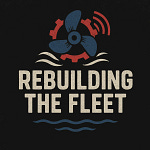Note: If you like Crossing the Valley, you’ll love the STEAM Zone, a new weekly show that covers the highlights from the last week in American industrial media / podcasts. The pilot is now live - watch here and let us know what you think!
Army CTO Dr. Alex Miller on Military Transformation at Scale
About Dr. Alex Miller
Dr. Alex Miller serves as the Chief Technology Officer of the United States Army, a position that oversees technology modernization across one of the world's largest and most complex organizations. An intelligence professional by trade, Miller was elevated to this strategic role to drive the Army Transformation Initiative—the most significant military modernization effort in decades. Working directly with Army Chief of Staff General Randy George and Secretary Dan Driscoll, he manages everything from organic industrial base operations (e.g., production of ammunition for the Joint Force) to next-generation command and control systems.
About the Army Transformation Initiative
The Army Transformation Initiative represents a fundamental shift in how the military acquires, tests, and fields technology. Directed by an April 30th memo from the Secretary of Defense, the initiative focuses on two critical areas: divesting outdated systems and investing in war-winning capabilities. The program encompasses everything from holistic soldier fitness to counter-drone warfare, magazine depth for missile systems, and close combat force equipment. What makes this transformation unique is its emphasis on real soldier testing through the "Transforming in Contact" program, where three brigades serve as beta testers for new technologies in demanding training environments. Rather than relying on contractor demonstrations, the Army is letting soldiers determine what works in actual field conditions—from Louisiana swamps to freezing German winters.
Key Takeaways
1. Test with end users in brutal real-world conditions, not conference rooms
The Army moved beyond PowerPoint demonstrations to testing with actual soldiers in extreme environments. They deliberately chose challenging conditions—swamps in summer, freezing rain in Germany—to stress-test technology before deployment. Miller emphasized: "I would rather all of those things fail in a training environment than what we had to do during the global war on terror." This approach revealed critical failures in batteries, drone rotors, and other systems that would have been catastrophic in combat. The lesson is clear: far better to put your solutions in the hands of actual users under the worst possible conditions before committing to scale.
2. Consolidate fragmented systems through unified authority structures
The Army discovered they had 17 different command and control systems attempting the same mission, each with separate program managers, funding lines, and incentive structures. Instead of trying to coordinate across all programs, they appointed a single boss with unilateral authority over all 17 programs. This person could mandate changes and build a unified platform from first principles using modern architecture. For organizations struggling with siloed solutions, the key is creating clear authority structures that can override individual program incentives in favor of enterprise-wide optimization.
3. Make divestment as strategic and rigorous as acquisition
Perhaps the most challenging aspect of modernization is killing old systems that no longer serve their purpose. The Army faced fierce resistance when divesting a $77 million drone contract for systems with sub-50% readiness rates. Miller noted: "It's going to be a bloodbath every single time, but it's the right thing to do for soldiers and taxpayers." They also made the difficult decision to stop Humvee production after 40 years, despite maintaining 103,000 vehicles. Successful transformation requires the discipline to stop funding legacy systems, even when it creates short-term political or organizational friction.
4. Integrate external talent while maintaining clear conflict boundaries
Through Detachment 201, the Army commissioned technology executives from companies like Palantir, Meta, and OpenAI as Lieutenant Colonels. These executives will work on problem identification and process improvement but are explicitly prohibited from touching solution development. This "church and state" separation allows the military to leverage Silicon Valley expertise while avoiding conflicts of interest. Organizations looking to bring in external talent should establish clear boundaries between strategy/problem identification roles and solution development to maintain integrity.
5. Build institutional momentum beyond personality-driven change
Miller emphasized that sustainable transformation can't depend on individual executives: "The worst thing possible is you have an executive who can only drive change because of personality." The Army focused on changing requirements processes, contracting structures, and organizational culture to create "irreversible momentum" that would continue regardless of leadership changes. This institutional approach to change management ensures that transformation efforts survive personnel transitions and become embedded in organizational DNA rather than dependent on specific champions.
Check out the full interview on YouTube and follow Crossing the Valley on LinkedIn!











